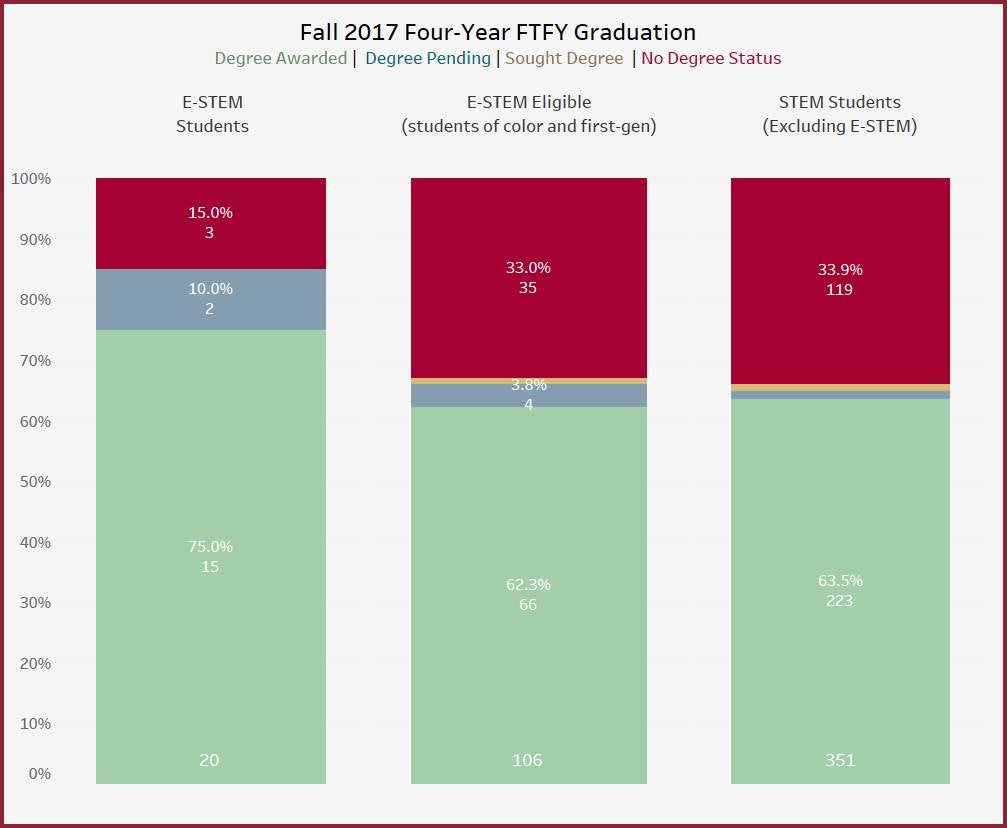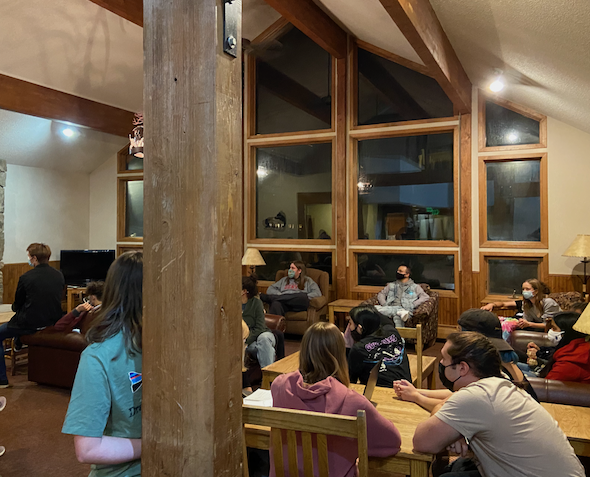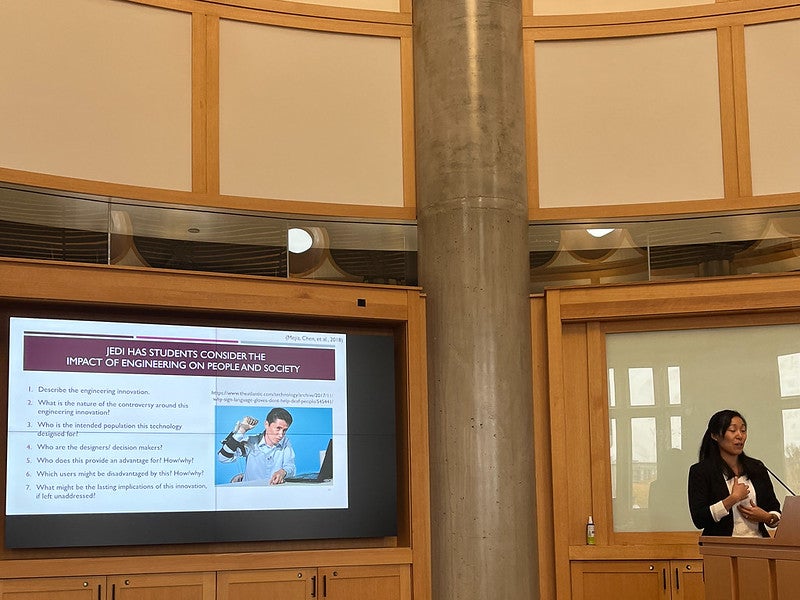The Equity in STEM Experience at the Ritchie School
Hector Rodrigues was not originally planning to join the Equity in Science, Technology, Engineering, and Math Program (E-STEM), but he is glad he did. All it took was a few phone calls encouraging him that he would make a good fit in the program, “a vibrant diverse community of STEM scholars,” as an incoming computer science major at the Ritchie School of Engineering and Computer Science of an underrepresented background.
In no time, he was fortifying his roots with a community who would provide the support needed for success at the University of Denver. Now a third-year and a peer mentor for the program, Rodrigues recognizes how important the program has been to his growth.
“Anytime I'm feeling stressed and overwhelmed, whenever we go to one of the sessions on Wednesday, I realize we're all feeling the same way,” he said. “I'm not alone.”
The E-STEM program was founded in 2017 with a singular vision in mind: provide historically underrepresented students with an on-campus community and promote academic and career success. Informed by the research of California State University Dean Emeritus Raymond Landis and scholarship from the National Society of Black Engineers, Director of Equity in STEM Anthea Johnson Rooen designed a program that accomplishes all these things and more.
In his paper, Landis describes how white students had historically benefitted from a collaborative learning environment, in which knowledge was readily shared and students held each other accountable. “Given this environment, how could one fail?” he wrote. “Almost none of us did.”
E-STEM’s 2017 foundation was to build a similarly “collaborative learning environment” that would work for historically underrepresented students in STEM, based on the guidance that Landis addressed. After being asked to design the program and begin recruitment in one month, Johnson Rooen used Landis’s “retention by design” framework to inaugurate a system that ensured the success of underrepresented students throughout their collegiate education and beyond.
The program’s efficacy is clearly represented in the data: according to internal research compiled in 2020, the persistence rate (students who return after one year) of full-time first-year students in E-STEM who did not persist is less than half of E-STEM eligible students and STEM students at large.
Graduation rates reflect this trend, with 75.0% of E-STEM students earning their degrees compared to E-STEM eligible students, 62.3%, and STEM students, 63.5%.
E-STEM students are clustered in common sections of first-year chemistry, calculus, and physics sequences, which are course series that all students must take, making “those three classes the most diverse classes at the university, Monday through Friday,” explained Johnson Rooen.
“The goal is to have one for every major sequence that students typically have,” said Rodrigues, who is advocating for another clustered offering for the Computer Science sequence to account for the many students in E-STEM within the major program.
Further support is provided at Academic Excellence Workshops (AEWs), which are dedicated study sessions where first-years can collaborate with each other or upperclassmen experienced in the subject.
“[The workshops] have been extremely helpful. Because you have people who know the content really well, but then you have those who don't,” Rodrigues said. “Since they have to go to the session at the same time, those who know it pretty well end up helping those who don't, and in the long run, they're both lifting each other up anyway, because you learned better through teaching.”
Community Building
Before the E-STEM program existed, minority students lacked an easily accessible avenue to community. The University of Denver is considered a predominantly white institution (PWI), with 65.3% of its student body identifying as white in Fall 2022. Within the Ritchie School of Engineering and Computer Science, in 2022, 29.7% of enrolled undergraduate students identified as people of color, a total of 171 students in a school of 575 undergraduates.
“Most stem positions tend to be very white male-dominated,” Rodrigues said. “So if you're not a white male, and you go into STEM, you already have this preconceived notion in your head. Like I'm an outsider trying to do something that I probably shouldn't be doing, which isn't the way it's supposed to be thought of.”
Understanding the effect that a PWI can have on underrepresented students, Johnson Rooen set out to unite this cohort with the Summer Bridge program. Incoming first-year STEM majors of minority race or ethnicity at the University of Denver are offered the chance to apply to join E-STEM ahead of time, as with other Living Learning Communities. But E-STEM members are offered the chance to move into a shared living space one week early, settling in with a community of students and participating in programming designed to ease the transition from high school to college.
Along with the clustered classes, weekly meetings throughout the first year orient students toward academic and personal development. From resumé workshops and biweekly study sessions to guest speakers and internship advising, Johnson Rooen and a network of peer leaders, a role for second-year students and above, partner with students to provide comprehensive access to resources.
“A lot of our programming is done the first year, so it's like the trunk of the tree,” Johnson Rooen said. “It's that foundation and as they go into their sophomore, junior, or senior year, that's when they're spreading out. And they're finding their own branches to this STEM tree.”
These sessions do not shy away from addressing the systemic challenges that minority students face. Students address inequity and prejudice head-on, examining students’ identities and how those identities can uniquely contribute to their field of interest.
Making up around a quarter of the entire U.S. workforce, STEM fields have been making gradual strides toward a diversified workforce, but structural inequity persists. According to the National Center for Science and Engineering Statistics, in 2020, “Hispanic, Black, and American Indian or Alaska Native STEM workers had lower median earnings than White or Asian STEM workers.” Women, who are underrepresented in STEM occupations, had lower median earnings than men in the same year.
Programs like E-STEM address these issues by ensuring that as many students cross the finish line as possible.
“Before E-STEM arrived on this campus, DU didn’t have anything like it. I don’t think anybody had thought about how we retain historically underrepresented students in the STEM fields. All of this is very new.”
Johnson Rooen spearheads the conceptual elements of the program while also remaining central to its everyday praxis. Not only does this include organizing recurring opportunities for students to glean useful information or experience, but her role also ordains a sizable amount of ad hoc advising, where she is able to build personal relationships with students in E-STEM and fortify their network of support.
She credits her mother, a nurse, and several strong mentors with acting as the foundation for her style of approach. Her background in communications prepared her to utilize the “tools in her toolbox” to be a resource and mentor to all 120 scholars involved in E-STEM.
“It's about reminding students that they’re not alone. And you don't get through this all by yourself. It's because you have friends.”
Students interested in joining E-STEM can apply ahead of their first year, after being accepted at DU, or at any point during their academic career. Find more information about E-STEM’s mission, offerings, and application process on their website. Learn more here about Equity and Inclusion at the Ritchie School.







